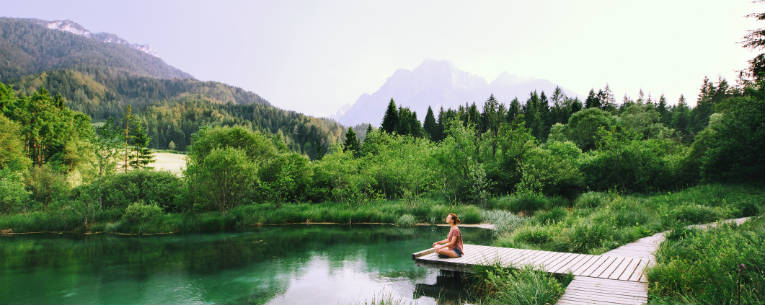Travel is magical. But sometimes, you want more than a trip to a place; your soul craves a journey to a new state of mind. That’s when it’s time to consider a silent meditation retreat.
There are all kinds of silent retreats — short and long, guided and freestyle, religious and secular. At some retreats, silence is fully enforced: no speaking, no asking questions. At others, silence may be observed only for part of the day, or in certain settings. Curious about the experience? Here are seven silent retreat destinations across the United States, from Maine to Arizona.
Tips for your first silent retreat
- Ease into silence. Don’t binge on Netflix, music or news prior to your trip. Prepare for your silent retreat by adapting its routines before you go: earlier bedtimes, healthier eating, and calming rituals.1
- Be patient with yourself. “Serenity now!” is not a useful mantra on a silent retreat. Your own brain will protest the experience of silence, activating the frenetic flow of thoughts some call “monkey mind.” Don’t get frustrated when this happens. “It takes at least 24 hours of silence for your thoughts to slow down and stop swinging from branch to branch, but once that happens, you’ll be able to relax into the silence,” says DoYouYoga.2
- Read the rules. While spiritual retreat centers want guests to feel welcomed, they typically have strict policies on what you can bring, what food is served, and what you can do while you’re there. Be sure you understand the rules before you go, because exceptions (for special diets or pets, for instance) are rare.
- Don’t cheat. You may be tempted to whisper something to a friend or sneak a look at your phone. As harmless as it may seem, breaking the rules will not only sabotage your own silent retreat experience but will disrupt others as well.
- It’s okay (even desirable) to keep to yourself. Many silent retreats tell participants not to acknowledge one another at all: no smiling, no eye contact, no waves, no hugs. “This can at times feel alienating and lonely for people who are very sociable and miss such simple human contact, but it will drastically help your experience of interiorization,” Hridaya Yoga advises.3
Silent retreat destinations in the U.S.
One of the best-known silent retreat destinations is Shambhala Mountain Center, a beautiful refuge in a mountain valley in Colorado. On its campus stands the Great Stupa of Dharmakaya, as well as accommodations that include rustic cabins, shared dorms, platform tents and cozy lodges. Shambhala offers guided silent retreats, as well as an abundance of other programs, from self-directed retreats to immersive guided meditations.
Cochise Stronghold is located on one of the Sky Islands: 57 forested mountains in the American Southwest and northwestern Mexico that are separated by seas of desert and grassland.4 Tucked into a canyon in southeast Arizona, Cochise Stronghold is a meditation retreat based on Buddhist practices that also welcome people from any spiritual tradition. Guests make their own meals and are asked to contribute at least 30 minutes of work each day.
Those seeking silence can find it at Texas’s Siddhayatan Tirth & Spiritual Retreat. If you choose, you can even take a (temporary) vow of silence under the direction of one of the resident monks. Silent retreats at Siddhayatan are unstructured and non-religious. Chant mantras each morning and evening (because mantras are divine sounds, chanting is not considered breaking silence).5 Meditate in the mandiram, read a book, or just soak up the sunshine while you sip hot chai.
“There are no rituals, required beliefs, or assigned practices” at Springwater Center, a silent retreat destination in New York’s Finger Lakes. “Grounded in the daily rhythm of timed sittings, a morning talk, and an hour-long work period with communally prepared food, people are free to conduct their retreat in any way they choose.”6 In fact, silent retreats at Springwater aren’t entirely silent — you may choose to engage in discussions or one-on-one dialogues. You can even get your room and meals for free (although retreat activities still have a cost) if you contribute your time by volunteering.
Rolling Meadows Retreat offers silent retreats and other programs in a 1840s farmhouse in rural Maine. Rolling Meadows hosts no more than 11 participants at a time and welcomes beginners, making it ideal for people who are trying their first silent retreat. Here, silence means “social silence”: people can ask questions during classes, but are asked to refrain from ordinary conversation.7 In your free time, you can hike, swim, cross-country ski or enjoy the wood-fired sauna.
The Abbey of Gethsemani in Kentucky is a Trappist monastery known as the longtime home of Thomas Merton, a monk, and author of “The Seven Storey Mountain.” Since 1848, the abbey has welcomed guests. Retreats at Gethsemani are “silent, unstructured and undirected,” although guests are welcomed (not required) to participate in the daily rituals of prayer, readings, and Eucharist.
Once a school and novitiate for young women taking religious vows, Mercy by the Sea Retreat and Conference Center on Long Island Sound is now a retreat center with a mission of helping people connect to the sacred. Mercy by the Sea hosts both individual retreats and directed retreats that explore Celtic Christianity, the feminine divine, contemplation, and creative expression, among other themes.8 If you’ve never tried a silent retreat, a good introduction might be the center’s Days of Mindfulness: Saturday sessions that teach loving kindness and meditation practices.
Travel insurance can be useful when planning a retreat, primarily to protect your prepaid, nonrefundable costs in case of trip cancellation/interruption and to help you deal with common travel problems, such as delayed flights and lost bags. Get a quote when you book your trip.
Related Articles








Share this Page